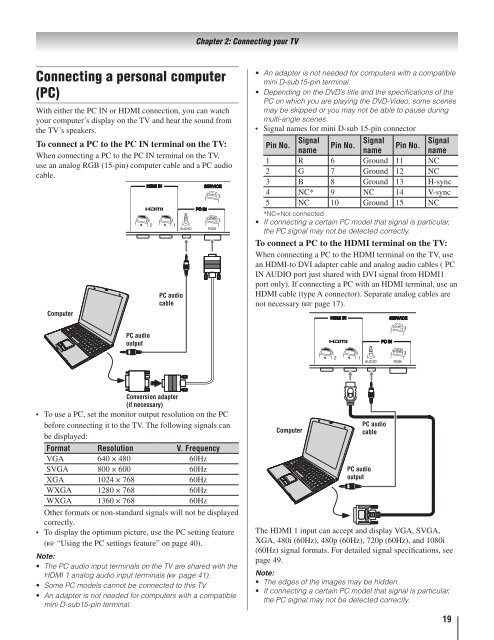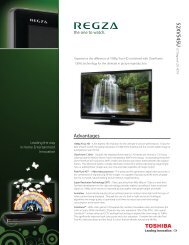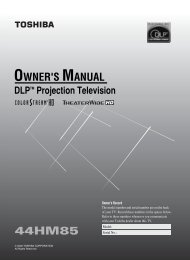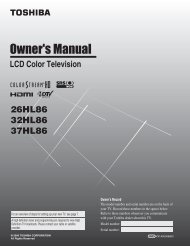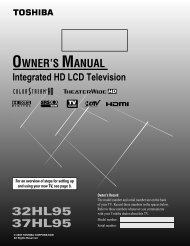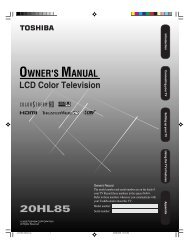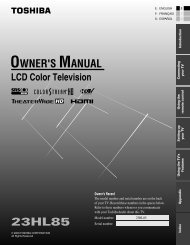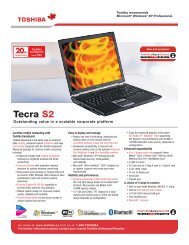LCD Television - Toshiba Canada
LCD Television - Toshiba Canada
LCD Television - Toshiba Canada
You also want an ePaper? Increase the reach of your titles
YUMPU automatically turns print PDFs into web optimized ePapers that Google loves.
Connecting a personal computer<br />
(PC)<br />
With either the PC IN or HDMI connection, you can watch<br />
your computer’s display on the TV and hear the sound from<br />
the TV’s speakers.<br />
To connect a PC to the PC IN terminal on the TV:<br />
When connecting a PC to the PC IN terminal on the TV,<br />
use an analog RGB (15-pin) computer cable and a PC audio<br />
cable.<br />
•<br />
•<br />
Computer<br />
PC audio<br />
output<br />
PC audio<br />
cable<br />
Conversion adapter<br />
(if necessary)<br />
To use a PC, set the monitor output resolution on the PC<br />
before connecting it to the TV. The following signals can<br />
be displayed:<br />
Format Resolution V. Frequency<br />
VGA 640 × 480 60Hz<br />
SVGA 800 × 600 60Hz<br />
XGA 1024 × 768 60Hz<br />
WXGA 1280 × 768 60Hz<br />
WXGA 1360 × 768 60Hz<br />
Other formats or non-standard signals will not be displayed<br />
correctly.<br />
To display the optimum picture, use the PC setting feature<br />
(� “Using the PC settings feature” on page 40).<br />
Note:<br />
• The PC audio input terminals on the TV are shared with the<br />
HDMI 1 analog audio input terminals (� page 41).<br />
• Some PC models cannot be connected to this TV.<br />
• An adapter is not needed for computers with a compatible<br />
mini D-sub15-pin terminal.<br />
Chapter 2: Connecting your TV<br />
•<br />
•<br />
•<br />
•<br />
An adapter is not needed for computers with a compatible<br />
mini D-sub15-pin terminal.<br />
Depending on the DVD’s title and the specifications of the<br />
PC on which you are playing the DVD-Video, some scenes<br />
may be skipped or you may not be able to pause during<br />
multi-angle scenes.<br />
Signal names for mini D-sub 15-pin connector<br />
Pin No. Signal<br />
name<br />
Pin No. Signal<br />
name<br />
Pin No. Signal<br />
name<br />
1 R 6 Ground 11 NC<br />
2 G 7 Ground 12 NC<br />
3 B 8 Ground 13 H-sync<br />
4 NC* 9 NC 14 V-sync<br />
5 NC 10 Ground 15 NC<br />
*NC=Not connected<br />
If connecting a certain PC model that signal is particular,<br />
the PC signal may not be detected correctly.<br />
To connect a PC to the HDMI terminal on the TV:<br />
When connecting a PC to the HDMI terminal on the TV, use<br />
an HDMI-to DVI adapter cable and analog audio cables ( PC<br />
IN AUDIO port just shared with DVI signal from HDMI1<br />
port only). If connecting a PC with an HDMI terminal, use an<br />
HDMI cable (type A connector). Separate analog cables are<br />
not necessary (� page 17).<br />
The HDMI 1 input can accept and display VGA, SVGA,<br />
XGA, 480i (60Hz), 480p (60Hz), 720p (60Hz), and 1080i<br />
(60Hz) signal formats. For detailed signal specifications, see<br />
page 49.<br />
Note:<br />
•<br />
•<br />
Computer<br />
PC audio<br />
output<br />
PC audio<br />
cable<br />
The edges of the images may be hidden.<br />
If connecting a certain PC model that signal is particular,<br />
the PC signal may not be detected correctly.<br />
19


